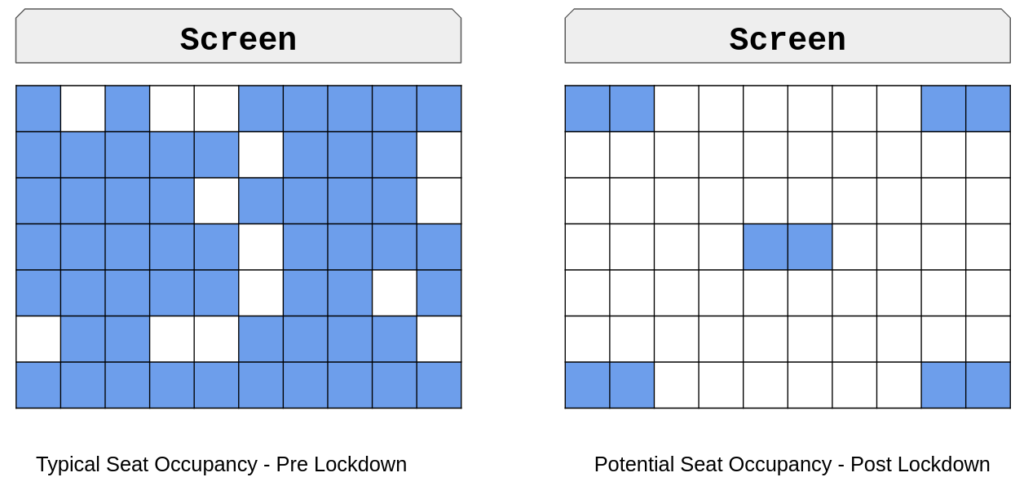The central mantra of 1989 American movie classic FIELD OF DREAMS is often misquoted as “If you build it, they will come”. It was in fact “he” not “they” but, misquote or not, it feels appropriate right now. Movie theaters around the country, and the world, are contemplating re-openings and what they might expect as different levels of social distancing measures are implemented. Two key questions arise: Will the audiences return? and What impact will social distancing have?
We are already getting a sense of an answer to the first question. Drive-In theaters around the country have been re-opening with numerous reports of sold out shows. Programming ranges from new releases like this weekend’s VALLEY GIRL, to recent hits like BAD BOYS FOR LIFE, to classics like JURASSIC PARK and, yes, FIELD OF DREAMS.
Traditional theaters have also started to re-open in some states. Last weekend (May 3-5) saw Texas, among others, allow re-openings with a 25% capacity restriction. Box office in the state, which already had open drive-ins, increased nearly four-fold from $33,400 the previous weekend to $122,400. This is hardly cause for major celebration – the entire weekend result is only one fifth of the lowest single-day (March 2) of box office recorded in Texas in 2020 ahead of the crisis shutdown – but it’s a step in the right direction.
The Hollywood Reporter reported that Santikos Entertainment had attracted nearly 3,000 moviegoers to three San Antonio locations with a discounted ticket price of $5.41. The three sites collectively delivered just shy of $16,000 with the Palladium 19 IMAX accounting for over $7,000 (approximately 1,300 customers). The Palladium showcased 13 films, including BLOODSHOT and I STILL BELIEVE (both released March 13, the last weekend before mass shutdown) and locally-flavored Jennifer Lopez classic SELENA (1997), a biopic of Texas-born singer Selena Quintanilla-Perez.
So, what about the impact of social distancing measures? In mid-May, Cinemark CFO and COO Sean Gamble addressed the issue of limited capacity head-on. Gamble told investors: “Even at peak periods of time in a normal environment, our occupancy levels on average typically range between 20% and 30%, and we can operate very profitably in those scenarios. Our lowest attended month had occupancy levels of 10% and we still operated profitability.”
While the same may not be true for all exhibitors, the statement suggested Cinemark was relatively unconcerned about the impact of such measures.
Gower Street has been examining how social distancing could affect daily box office potential. Understanding the implications of these constraints enables us to continue making long-term forecasts and make sense of the post-lockdown cinematic landscape.
To determine how much one cinema can gross in a single day, we use the following equation:
Maximum Day Gross = No.Seats ✕ No.Shows ✕ Ticket Price ✕ Occupancy Factor
As an example, let’s calculate the maximum day gross potential for one site in Texas. The sample theater chosen has approximately 6,000 seats (across 30 auditoria) and for illustrative purposes we assume an average ticket price of $10 with 4 showings a day. In normal operating conditions the occupancy factor is 1, meaning that every seat ‘can’ be filled per show.
Maximum Day Gross = 6000 ✕ 4 ✕ $10 ✕ 1 = $240k
This number reflects the maximum potential gross on any given day, if every seat for every show was sold at the given ticket price. Of course, it is a simple abstraction that doesn’t account for different ticket price structures, deals, etc. However, simple methods allow reasonable estimates to be made from a few assumptions and little information, which is useful from a forecasting perspective in the current, fluid situation.
Now, what does the maximum potential for the sample theater look like when we account for strict social distancing measures, assuming couples can sit in pairs but must be 2 meters from other customers? The figures below demonstrate what a typical seating chart may look like pre and post-lockdown.

The example shows a screening with 80% of seats sold, typical of an opening night of a big release pre-lockdown. This is contrasted by a sparsely populated seating chart, where patrons have to be spaced approximately 2 meters or more. Accounting for the wide range of seating width in theaters, we determined a strict 2-meter spacing would result in a maximum occupancy factor of roughly 14% post-lockdown.
If rules are relaxed to allow closer seating, we determined an upper bound of roughly 33% occupancy factor. Of course, rules for social distancing will vary across states and layout, seat size and booking patterns will vary from theater to theater. However, this simple idea allows us to try and account for the impact of distancing measures going forward.
Lastly, there is an additional assumption that exhibitors may have to reduce shows from 4 to 3 per day, either running at reduced capacity or to carry out time-intensive deep-cleaning between shows. Coming back to our Texas sample theater, with a strict social distancing protocol and reduced shows, we can evaluate its new maximum daily potential:
Maximum Day Gross = 6000 ✕ 3 ✕ $10 ✕ 0.14 = $25.2k
Clearly, that would be a staggering drop in potential revenue. In 2019, the theater in question grossed more than $25.2k on half of the days in the year. However, if measures were relaxed to allow a 33% occupancy factor that would allow for an upper limit of $59.4k. Only 22 days in 2019 delivered higher results.
This is a simple example to illustrate the methodology. We can now extrapolate it up to calculate potential daily maximums constrained by social distancing for the entire Domestic market, by treating the territory as one gigantic theater. We have about 60% coverage of seat numbers per theater across the Domestic market, which we use to extrapolate a full estimate for total number of seats, approximately 7.7 million. We use an average ticket price of $9.16, based on 2019 information. Thus, for a strict 2-meter social distancing protocol, we estimate the maximum daily potential for the Domestic market is:
Maximum Day Gross = 7.7M ✕ 3 ✕ $9.16 ✕ 0.14 ≅ $30M
And with relaxed social distancing protocols:
Maximum Day Gross = 7.7M ✕ 3 ✕ $9.16 ✕ 0.33 ≅ $70M
We can view these as lower and upper bounds of daily potential box office gross in a post-lockdown landscape. In 2019, 165 days grossed above $30 million (in 2019 there were 165 days accounted for by Fridays, Saturdays, Sundays and national holidays). However, only 14 days grosses above $70 million. It is therefore easy to gauge how much more impactful strict social distancing measures will be to the daily market totals.
These constraints will inevitably require exhibitors and distributors to think about their offering, at least in the short term, to try and maximize the potential of weekday revenues and tent-pole releases. This may lead to multiplexes initially playing major blockbusters on greater numbers of screens; tent-poles playing longer in theaters; a reduced studio theatrical slate; and mid-week dynamic programming options. If exhibition and distribution can work together to overcome these restrictions the outlook need not look so bleak. After all, if the market were able to generate $30 million every day that would deliver a near-$11 billion calendar year.
This article was originally published in Screendollars’ newsletter #116 (May 11, 2020).
Rob Mitchell contributed to this article.



